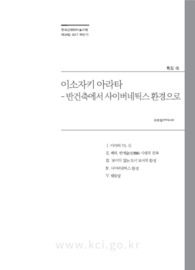

PARTNER
검증된 파트너 제휴사 자료
이소자키 아라타 - 반건축에서 사이버네틱스 환경으로 (Isozaki Arata: From Anti-Architecture to Cybernetic Environment)
24 페이지
최초등록일 2025.05.06
최종저작일
2017.12

-
미리보기
서지정보
· 발행기관 : 한국근현대미술사학회(구 한국근대미술사학회)
· 수록지 정보 : 한국근현대미술사학(구 한국근대미술사학) / 34호 / 183 ~ 206페이지
· 저자명 : 조현정
초록
Isozaki Arata is one of the most distinguished practicing architects in the world today, not only for his experimental designs but also for his rigorous architectural theses. He is most well known as a pioneering figure of the postmodern trend with his designs of the 1970s and 1980s.
However, this study is not a comprehensive survey of Isozaki’s entire career from the 1960s to the present, but a specific look at his formative years when the architect began to articulate his own design methodology. Particular emphasis is given to the architect’s active interactions with the 1960s art circles with an intention to discuss the convergence of creative individuals and cross-disciplinary connections that occurred in postwar Japan.
The study examines the dual identity of Isozaki as both artist and architect. If Isozaki’s identity as an architect was formed by his training in Tange Kenzō’s office and his collaboration with the Metabolists, his alter-identity as an artist was indebted to his encounter with the 1960s radical artists. First, it delineates Isozaki’s encounter with the avant-garde art movement of the 1960s, collectively called “Anti-Art,” against the backdrop of the “anti-spirit” of Japanese society. Then it discusses how Isozaki’s interaction with contemporary artists helped him to formulate the idea of “invisible city,” a radically new design concept which was closely linked to the radical expansion of the nature of architecture from isolated built forms to allencompassing natural and manmade environments. The notion of “invisible city” took concrete shape with a dialogue with environment art and it was eventually channeled into a cybernetic model of architecture and urbanism.영어초록
Isozaki Arata is one of the most distinguished practicing architects in the world today, not only for his experimental designs but also for his rigorous architectural theses. He is most well known as a pioneering figure of the postmodern trend with his designs of the 1970s and 1980s.
However, this study is not a comprehensive survey of Isozaki’s entire career from the 1960s to the present, but a specific look at his formative years when the architect began to articulate his own design methodology. Particular emphasis is given to the architect’s active interactions with the 1960s art circles with an intention to discuss the convergence of creative individuals and cross-disciplinary connections that occurred in postwar Japan.
The study examines the dual identity of Isozaki as both artist and architect. If Isozaki’s identity as an architect was formed by his training in Tange Kenzō’s office and his collaboration with the Metabolists, his alter-identity as an artist was indebted to his encounter with the 1960s radical artists. First, it delineates Isozaki’s encounter with the avant-garde art movement of the 1960s, collectively called “Anti-Art,” against the backdrop of the “anti-spirit” of Japanese society. Then it discusses how Isozaki’s interaction with contemporary artists helped him to formulate the idea of “invisible city,” a radically new design concept which was closely linked to the radical expansion of the nature of architecture from isolated built forms to allencompassing natural and manmade environments. The notion of “invisible city” took concrete shape with a dialogue with environment art and it was eventually channeled into a cybernetic model of architecture and urbanism.참고자료
· 없음태그
-
자주묻는질문의 답변을 확인해 주세요

꼭 알아주세요
-
자료의 정보 및 내용의 진실성에 대하여 해피캠퍼스는 보증하지 않으며, 해당 정보 및 게시물 저작권과 기타 법적 책임은 자료 등록자에게 있습니다.
자료 및 게시물 내용의 불법적 이용, 무단 전재∙배포는 금지되어 있습니다.
저작권침해, 명예훼손 등 분쟁 요소 발견 시 고객센터의 저작권침해 신고센터를 이용해 주시기 바랍니다. -
해피캠퍼스는 구매자와 판매자 모두가 만족하는 서비스가 되도록 노력하고 있으며, 아래의 4가지 자료환불 조건을 꼭 확인해주시기 바랍니다.
파일오류 중복자료 저작권 없음 설명과 실제 내용 불일치 파일의 다운로드가 제대로 되지 않거나 파일형식에 맞는 프로그램으로 정상 작동하지 않는 경우 다른 자료와 70% 이상 내용이 일치하는 경우 (중복임을 확인할 수 있는 근거 필요함) 인터넷의 다른 사이트, 연구기관, 학교, 서적 등의 자료를 도용한 경우 자료의 설명과 실제 자료의 내용이 일치하지 않는 경우
“한국근현대미술사학(구 한국근대미술사학)”의 다른 논문도 확인해 보세요!
-
제국일본의 식민지배와 공공기념물 28 페이지
It is from the late 19th century when large monuments began to be constructed in public spaces in Korea. As the Emperor Gojong constructed the monument for the 40th anniversary of inauguration of the .. -
사진적 예술 - 오카다 하우스의 시각성 17 페이지
This essay examines the relationship between art and architecture through the photographic art of the Okada House (1933) designed by pioneering modern architect Horiguchi Sutemi (1895–1983). While the.. -
1960년대 말 한국미술과 건축에서의 ‘환경’ 33 페이지
This paper aims to offer an understanding of the ways in which the intersection between art and architecture took place during the 1960s, in which a wave of new hope in the wake of the Korean war's de.. -
이토 도요, 이시오카 에이코, 그리고 ‘여성 도시 노마드’라는 환상 29 페이지
At the height of Japan’s economic bubble in the 1970s and 1980s, one fantasy that circulated widely through advertising posters of the designer Ishioka Eiko, ephemeral “nomadic” architecture of Itō To.. -
일본의 포스트버블 시대 미술계로 침공한 건축 30 페이지
There has been a boom in art festivals in various parts of Japan. Its starting point can be traced back to Christo & Jeanne-Claude’s <Umbrella Project> (1991) in which artwork was displayed in a rural..
문서 초안을 생성해주는 EasyAI
